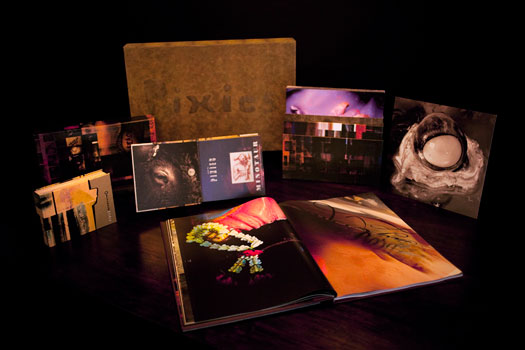
The Pixies box set Minotaur designed by 4AD
In 2009, the English designer Vaughan Oliver met Adrian Shaughnessy to show him preliminary work on a deluxe Pixies box set called Minotaur. Oliver asked Shaughnessy to write a short text about the packaging for inclusion in the box set. The text was never used.
A chic café next to the Royal Festival Hall on the banks of the river Thames, London. It’s mid-afternoon and Vaughan Oliver is talking about blood, sex and death. He pulls photographs from his bag like doves from a magician’s hat. It's the 4AD dream team again. Photographer Simon Larbalestier and designer Vaughan Oliver. They are working on a collector’s box set of five Pixies albums: a loving homage to the Boston rockers. No new songs, but all the artwork and imagery is new.
Larbalestier has been living in Thailand. It shows in his pictures. He has been patrolling the murky zones of sex, religion and body politics. We look at sutures, crucifixes and shards of indeterminate anatomy. His images of eroticised Catholicism have a newfound Oriental inflexion. Plaster saints in terrifying close-up; bleached bones; Bangkok sex-tourist neon.
Oliver lives in Epsom, Surrey. Suburban England. Home of insurance brokers and people who make the daily half-hour trip to London on crowded, commuter trains. Unspeaking, they read newspapers and dream of retirement and long days of golf in damp English afternoons. Epsom is a long way from Thailand; it’s a long way from Oliver’s native Durham in the hard North East of England; it’s a long way from Boston, Massachusetts.
Oliver says proudly that Aubrey Beardsley lived in Epsom. Beardsley is the patron saint of English weird. The first superstar of English graphics. A consumptive who coughed blood into his handkerchief and saw his own death in the red stigmata on the white linen. Dead at 26.
Oliver produces more pictures; a tabletop movie of dark beauty. The staff in the café, who have accents from France and Eastern Europe and probably have university degrees in difficult subjects, glance at the images; a waiter with dreadlocks piled up on his head, does a double take. A Pixies fan? A Vaughan Oliver fan? But he doesn't linger. He looks away and serves Brownies and tea to people with time to kill before attending afternoon poetry readings or Gamelan workshops at the Royal Festival Hall.
Vaughn Oliver explains his new role as art director and image editor. A grandee of graphic design now, he has others do the work while he watches and edits. Under his attentive gaze an army of student helpers, many of them born after the release of Surfer Rosa, work with Oliver to forge a new Pixies’ iconography. He watches, ever vigilant for the happy accident or the unintended collision, as the typography for all five Pixies 4AD albums is warped, twisted and distressed and as entirely new styles and forms emerge from the eager minds of his students.
Oliver, the wizard of the image-meld, pushes Larbalestier’s photographs up hard against ghostly fragments of Pixies’ graphic mythology. Pictures of abandoned gloves and rosary beads (stills from an imaginary Tarkovsky movie) are slammed against a new Pixies visual lexicon created by the students.
But why a book? Why a box set? Why all this physical-world matter? After all, we live in the age of the audio download — a super-convenient data stream of invisible ones and zeros that arrive in our laptops, cell phones and iPods within seconds of being summoned. No waiting. No hanging about in record shops. No browsing through inky music papers. No delayed pleasure. Only instant demand and instant gratification. All the music we ever need held in a zippy piece of 21st century product design smaller than a cigarette packet. Soon we’ll have an implant in our brains and all the data in the world will be streamed into our heads, where it will float about like the messages heard by clinically insane serial killers.
But why a book? Why a box set? Why all this physical-world matter?
Because we love the realworld touch of paper, ink and cardboard. Because you can’t scratch an MP3 file; it never gets dust on it; it never develops the patina of age. Even some of my CDs, bought in the first wave of digital technolust of the 1980s, have turned tobacco yellow. But an MP3 file? It’s just audio vapour. A keystroke away from deletion.
A box set is like the Pixies live — you can feel the air displacement as the sound hits you.
Like the opening bars of Monkey Gone to Heaven or Debaser — a box has heft and dimension. You can feel it. You can touch it. Like Minotaurs in Epsom, it’s real. Not imagined.


Comments [6]
11.10.10
11:12
11.11.10
12:37
11.11.10
04:45
11.12.10
04:09
11.18.10
10:58
11.18.10
11:08